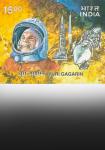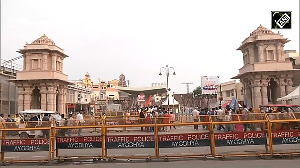Barnes, a textile curator from the Department of Eastern Art at The Ashmolean Museum at Oxford is sharing a quick lunch in the chaotic National Museum canteen, Delhi, with fellow textile scholar Rosemary Crill from the South Asian Department of the Victoria & Albert Museum, London.
It is 'Masters of the Cloth', an exhibition of "Indian textiles traded to distant shores", or the TAPI collection, that has brought the two textile curators to speak on a symposium on Indian trade clothes.
The exhibition displays an impressive private collection of Indian textile from the 13th to the 20th centuries that originated in India but were not preserved.
Destined for export, they withstood time on foreign shores and became a prominent part of those cultures -- at times serving as costumes for the nobility, festive displays and gifts.
Take the silk patola, which was among the most prestigious textiles traded to South-east Asia, and became the prerogative of Indonesian royalty and nobility. Or the hand-woven cotton plaid, checked or striped Indian Madras cloth that reached West Africa and became a symbol of the cultural identity of the Kalabari community.
Kashmir shawls were a favourite in Persia and Europe. By the 19th century, they became the rage in France and their price varied form 1,700-3,000 francs each.
Tracking the history and diversity of trade textiles from India, Crill is surprised to find that "though there is adaptation, a lot of the prints and weaves are still preserved".
Pieces of cloth get added to the already 10,000 pieces of textile traditions from South Asia at The Ashmolean museum when Crill sees that a particular textile tradition is fading. "As there is so much new happening in India with textiles, we want to formulate a strategy to cover all new different traditions," she adds.
Dr Barnes, on the other hand, is amazed at the textile prints influenced by other media. "The crossover of designs in architecture, wood-carvings, paintings and textiles in India is remarkable," she says.
As textile exports to foreign lands grew, so did the changes in designs and patterns that responded to the needs of distant markets.
A gilded chintz palampore displayed at the TAPI Collection made in the 18th century on the Coromandel Coast for the Western market is a perfect example of this.
The embroidered palampore had a centrally positioned angular flowering tree with songbirds indicating a Chinese influence, and floral swags demonstrating European taste, with Indian gold leaf applied work on the designs.
But Dr Barnes notes that designs that changed and responded to fashion were the main designs. "Border patterns survived and are still seen extensively."
She marvels at the quality of the Indian craftsmanship being "significant" as seen in pieces displayed at the TAPI Collection and the numerous textiles studied by her through the years. "There was a decline in the quality of textiles produced by India in the 20th century, but there has been a revival. The intricacy and quality of Indian craftsmanship has been retained to a great extent," says Barnes.
Both curators feel Indian textiles and designs are hugely popular abroad and have great scope, but refuse to comment on ways the local craftsmen whose textile traditions are dying could explore these markets.
But Dr Barnes is positive that "globalisation has encouraged production of local textile traditions" and "the window is certainly bigger".








 © 2025
© 2025